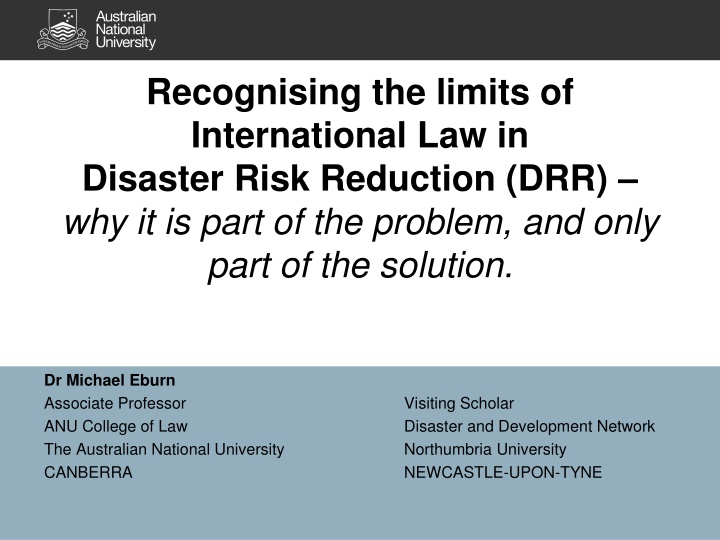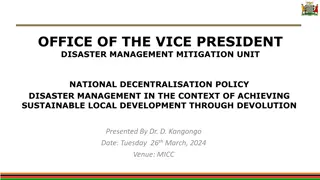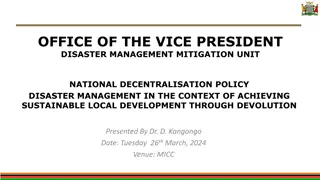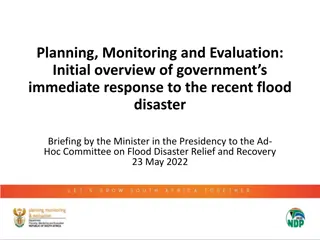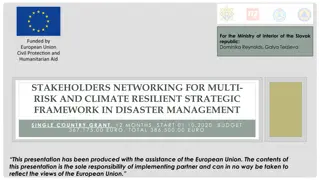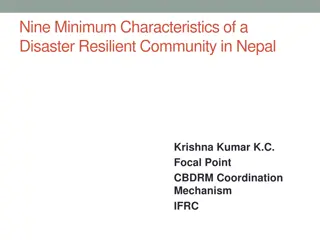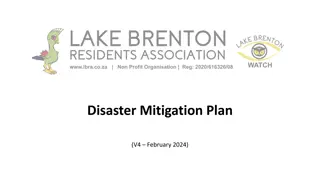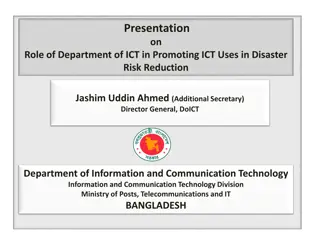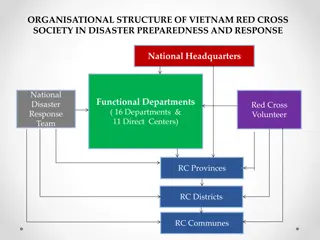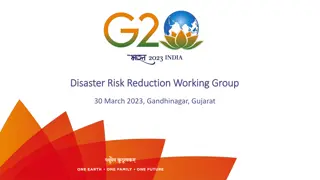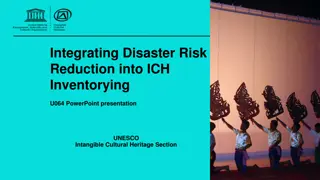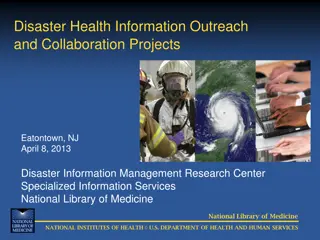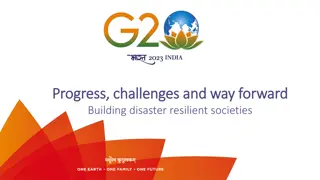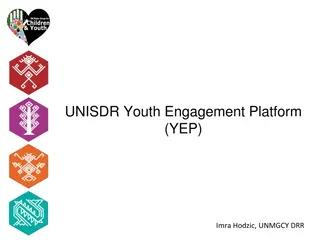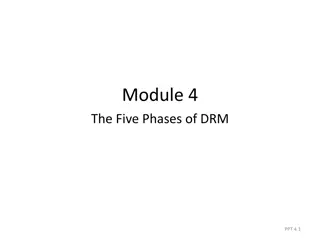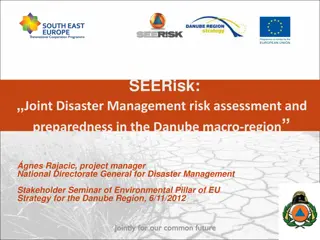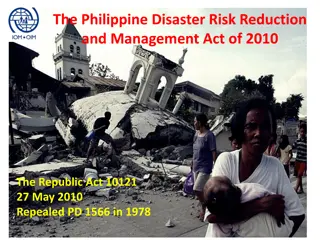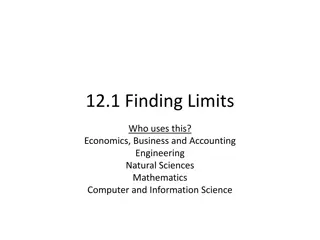Limits of International Law in Disaster Risk Reduction
Recognizing the historical context and developments in international disaster law, this article explores the evolving role of international law in disaster risk reduction, highlighting its challenges and potential contributions. The analysis delves into the role of NGOs, civil society, and academics in shaping international legal frameworks, emphasizing the importance of state interests in the effectiveness of international law for disaster management.
Download Presentation

Please find below an Image/Link to download the presentation.
The content on the website is provided AS IS for your information and personal use only. It may not be sold, licensed, or shared on other websites without obtaining consent from the author.If you encounter any issues during the download, it is possible that the publisher has removed the file from their server.
You are allowed to download the files provided on this website for personal or commercial use, subject to the condition that they are used lawfully. All files are the property of their respective owners.
The content on the website is provided AS IS for your information and personal use only. It may not be sold, licensed, or shared on other websites without obtaining consent from the author.
E N D
Presentation Transcript
Recognising the limits of International Law in Disaster Risk Reduction (DRR) why it is part of the problem, and only part of the solution. Dr Michael Eburn Associate Professor ANU College of Law The Australian National University CANBERRA Visiting Scholar Disaster and Development Network Northumbria University NEWCASTLE-UPON-TYNE
Historically, little (not no) interest by the international community in DRR 1927 Convention and Statute Establishing the International Relief Union (entered into force 27 December 1932). The IRU provided assistance following earthquakes in 1934 (India & Nepal) and 1935 (in what is now Pakistan). 1984 Draft Convention on Expediting the Delivery of Emergency Assistance was not adopted. 2
Since 2004 Massive increase in the number of books and academics working on international disaster law. Increase in international law instruments: Hyogo Framework for Action 2005-2015; IFRC s Guidelines for the Domestic Facilitation and Regulation of International Disaster Relief and Initial Recovery Assistance (2008); Sendai Framework for DRR 2015-2030; Framework Convention on Climate Change (2016); ILC s Draft Articles on the Protection of Persons in the event of Disasters (2016). 3
What changed? 2004 Indian Ocean tsunami? Growth in size of the NGO sector leading to pressure on governments both pre- and post disaster? The increase in demands for international assistance and recognition that prevention is better (and cheaper) than cure? 4
NGOs, civil society and academics Have a more direct input into the creation of international law than they do domestic law. The ICJ is to consider the teachings of the most highly qualified publicists of the various nations, as subsidiary means for the determination of rules of law (Statute of the International Court of Justice, Art. 38). Greater faith in and commitment to the promise of international law ? (Alan Boyle and Christine Chinkin, The Making of International Law (Oxford, 2007, p. 12). 5
Does international law really help? International law works best when state interests coincide areas such as diplomatic privileges, territorial jurisdiction, extradition, wide fields of maritime law, arbitral procedure, and so forth . Where there is neither community of interests nor balance of power, there is no international law . Hans J. Morgenthau, Positivism, Functionalism, and International Law (1940) 34(2)The American Journal of International Law 260-284. 6
Where does DRR/IDR sit? With natural disasters, the interests of both the victim and assisting states converge on maintaining as much sovereignty as possible a convergence that does not stimulate the robust development of international law. David Fidler, Disaster Relief and Governance after the Indian Ocean Tsunami: What Role for International Law? (2005) 6(2) Melbourne Journal of International Law 458-473. 7
In IDL sovereignty is the driving force UNGA Resolution 46/182 on Strengthening of the coordination of humanitarian emergency assistance of the United Nations The sovereignty, territorial integrity and national unity of States must be fully respected in accordance with the Charter of the United Nations. 8
Sendai Doesn t mention sovereignty but does say Each State has the primary responsibility to prevent and reduce disaster risk [19(a) Guiding Principles] 9
The International Law Commission reaffirms the primary role of the affected State in the provision of disaster relief assistance, which is a core element of the draft articles. The reference to sovereignty, and the primary role of the affected State, provides the background against which the entire set of draft articles is to be understood. (Draft Articles on the Protection of Persons in the Event of Disasters, Commentary, Preamble [6] (2016)). 10
International Disaster RESPONSE law Responsibility for management of disaster response is vested with the government of the affected state (UN Resolution 46/182). Other states can only provide assistance with the consent of the affected states. Do states really refuse assistance? Or is the bigger problem managing assistance from non-state actors? 11
NGOs Are not the subjects of international law. NGOs arise out of necessity Tasmania Fires Can we Help; Blaze Aid; Christchurch Student Army. 12
The Red Cross/Red Crescent IDRL project Moved away from an international law solution. Output: Guidelines for the Domestic Facilitation and Regulation of International Disaster Relief and Initial Recovery Assistance . 13
The ILC articles are more than a codification Art 8: Duty to cooperate; Article 11: Duty to reduce the risk of disasters; Article 13: Duty of the affected State to seek external assistance. 14
The obligations are vague States shall, as appropriate, cooperate among themselves Each State shall reduce the risk of disasters by taking the necessary and appropriate measures If a disaster exceeds its national response capacity, the affected State has the duty to seek assistance as appropriate. Consent to external assistance shall not be withheld arbitrarily. 15
Relying on Law Can lead to a focus on compliance and an expectation that everyone will follow the law or the plan. People don t and neither do disasters. no plan survives contact with the enemy 16
Whats to happen with the draft articles? They become a non-binding UN resolution or A treaty. There has been no indication that the international community wants a treaty or wants to enter legally binding agreements to accept or offer aid. 17
What about DRR? Consider Sendai States are to take into consideration , act as appropriate , with regard to national laws and as mutually agreed 18
Priority 3: Investing in disaster risk reduction for resilience 29. Public and private investment in disaster risk prevention and reduction through structural and non-structural measures are essential to enhance the economic, social, health and cultural resilience of persons, communities, countries and their assets, as well as the environment. These can be drivers of innovation, growth and job creation. Such measures are cost-effective and instrumental to save lives, prevent and reduce losses and ensure effective recovery and rehabilitation 31. To achieve this, it is important: (e) To enhance cooperation between health authorities and other relevant stakeholders to strengthen country capacity for disaster risk management for health, the implementation of the International Health Regulations (2005) and the building of resilient health systems; 19
So what Declarations like Sendai are helpful. Point in a common direction and policy goals. May be a tool for diplomacy. Encourage compliance as states want to be seen to be good citizens. 20
But International law is unlike domestic law. It does not contain (usually) explicit requirements. Enforcement depends on political will and disapproval . Declarations like Sendai soft law don t commit any state to anything in particular. 21
Countries Appear unwilling to accept universal binding obligations with respect to DRR and disaster relief. International law remains weak focused on ensuring the rights of states to make their own decision and avoiding commitments on other states to assist. 22
International law Is part of the problem focus on preserving sovereignty. And only part of the solution it gives a gentle push. It s (generally) not binding on states, or non-state actors. The real solutions lie in domestic laws and regional arrangements. 23
Why is that conclusion important? Don t let faith in and commitment to the promise of international law be misplaced. International legal developments are good, but don t expect too much from them. 24
Questions? Comments? Thank you for your attention. Dr Michael Eburn Australian National University, College of Law and Northumbria University, Disaster and Development Network E: michael.eburn@anu.edu.au E: michael.eburn@northumbria.ac.uk P: +61 2 6125 6424 (Australia) P: +44 737 621 6647 (UK) 25
